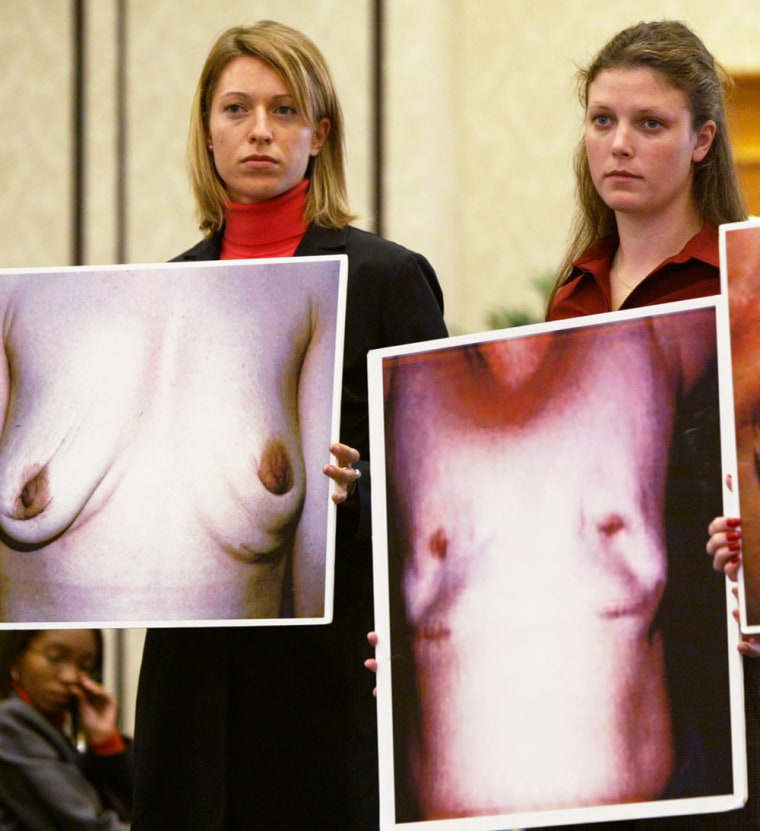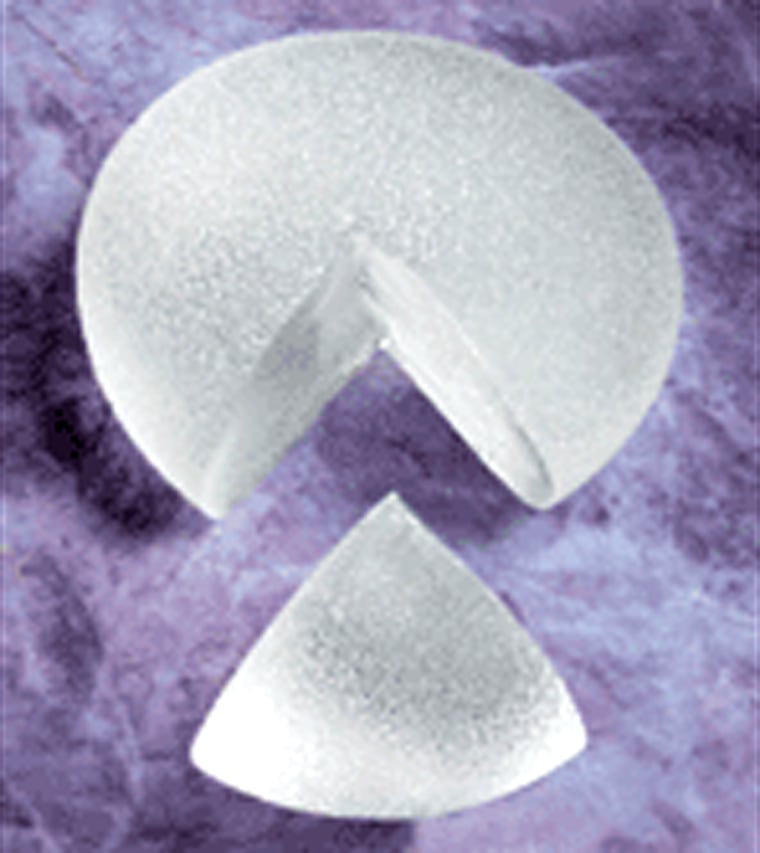Many women hoping for a more natural-looking alternative to saline breast implants were disappointed by the Food and Drug Administration's recent decision to maintain the ban on silicone-gel-filled implants. But there may be other options on the market one day, as doctors continue their quest to find better ways to boost a woman's bosom.
Among the most promising developments, they say, are cohesive silicone gel, leak-resistant implants with the consistency of a gummy bear and a new type of implant shell coating that may be less likely to cause inflammation and scarring in the surrounding breast tissue.
“I think we are getting closer to developing the perfect implant, in terms of durability, biocompatibility and natural shape,” says Dr. Mark Jewell, a plastic surgeon in Eugene, Ore., and vice president of the American Society for Aesthetic Plastic Surgery.
Safety concerns linking ruptures of the silicone gel implants to autoimmune problems in some women caused the FDA to ban the sale of the implants in 1992, except for use in clinical trials and by women undergoing breast reconstruction. While the implants were somewhat exonerated by an Institute of Medicine report saying they do not up the risk of autoimmune disease, the new FDA ban calls for more study before they can be put back on the market.
Both saline- and silicone-filled implants have a silicone shell. But if the saline implants leak, deflate or rupture, which they often do, they would release only salt water -- not silicone -- into the body. The downside of the saline implants, though, is that they don't look and feel as natural as the others.
“Some people are concerned about the safety of silicone gel and many people are disappointed about the performance of saline implants, notably that they are associated with more ripples, have a more liquid feel and don’t look as natural as the silicone implants,” says Dr. Grant Stevens, medical director of Marina Plastic Surgery Associates, with locations in Marina Del Rey and Palos Verdes, Calif.
'Gummies'
Enter cohesive gel implants, which are currently on the market in Europe and Brazil, and now being studied in the United States.
"The ‘gummy bear’ implants have the positive attributes of the silicone gel, but lack the concerns of gel migration,” says Stevens, who is one of 15 U.S. doctors participating in a study of Silimed cohesive gel implants.
Dr. William P. Adams, Jr., agrees. “The gel doesn’t migrate, so there are potential safety benefits because if the shell should fail, the gel will not go anywhere -- it would just stay in one place,” says Adams, an associate professor of plastic surgery at the University of Texas Southwestern Medical Center in Dallas.
And unlike saline implants, Stevens notes, “cohesive gel implants feel like breast tissue, not a water balloon.”
So far, he adds, the data and patient response are “overwhelmingly positive.”
Last October, 42-year-old Charlie Sheridan, who works in Stevens' office, traded in her saline implants for a pair of cohesive gel implants as part of the clinical trial.
“I am sporting a pair of gummies,” Sheridan says. “They have the look and feel of silicone, but don’t have the hardness or lack of naturalness of saline and there is no worry of deflation,” she says. One of her saline implants did, in fact, deflate which is why she opted for the newer model.
The companies Inamed and Mentor also are conducting studies of their versions of the cohesive gel implants.
Experts in the field say it could be at least three to five years before any such product is on the U.S. market, provided the FDA approves one.
But not all plastic surgeons are completely sold on these new implants.
“The problem is density,” says Dr. Lawrence Reed, a New York City plastic surgeon. “They may have value in reconstructive procedures because you need density and mass, but for normal women, they are too dense,” he says.
“Cohesive gel is a refinement of the current silicone implant, but it’s harder than usual silicone gel, so it’s not the total answer,” agrees Dr. Rod J. Rohrich, president of the American Society of Plastic Surgeons and the chairman of the department of plastic surgery at the University of Texas Southwestern Medical Center.
Another product in the pipeline, he notes, is an implant filler made with a substance called polyethylene glycol.
“It contains a patented blend of polyethylene glycol and saline and results in an implant that has the look and feel of silicone,” says Rohrich, who helped develop the substance.
Hopes for indestructible implants
Titanium-coated breast implants may also be an option in the future. The product of a partnership between Poly Implants Prostheses, a French company specializing in implants, and GfE, a German aerospace company, Tibreeze implants are coated with a thin layer of titanium and filled with silicone gel.
“It’s not like you dip it in molten titanium, it’s a thin coating that bonds to the silicone,” Jewell explains.

“Titanium is a more biocompatible metal than even stainless steel,” he says, meaning that it is less likely to cause a toxic or otherwise injurious reactions in the body.
Researchers are hopeful that by coating the shell, the implant will be more resistant to infection, stronger and will produce less scarring and capsular contracture, a condition that occurs when scar tissue forms around the implant and results in painful stiffness of the breast and possible leakage of the substance inside the implant.
So far, Jewell says, three women have received the implants as part of a clinical trial in Germany that began last year.
“We don’t know yet if it will have a durability advantage,” he adds.
Lunch-time breast lifts?
Women can get lunch-time injections of Botox and various facial fillers, and now researchers in Sweden may have found a way to boost a woman's breast size during the lunch hour as well.
In the near future, Rohrich says, injections of hyaluronic acid, a compound used to fill fine lines and wrinkles, could be used to do temporary breast enhancement.
"It is a non-surgical procedure and can be used to build up breast tissue and enhance the breast for a couple of years,” he says.
Currently the injections are being performed as part of pilot studies in Sweden by the manufacturer, Q-Med. Enhancements, however, are not permanent and eventually the hyaluronic acid will be re-absorbed into the body.
Peering into his crystal ball, Rohrich forecasted what else may be on the distant horizon, including grow-your-own breast implants.
“We may one day make our own implants from our own fat where surgeons harvest fat via liposuction and stimulate it to grow," Rohrich says, "so it will be natural but to grow that amount of fat and grow it consistently may be years and years away."
Denise Mann is a health writer based in New York City.
